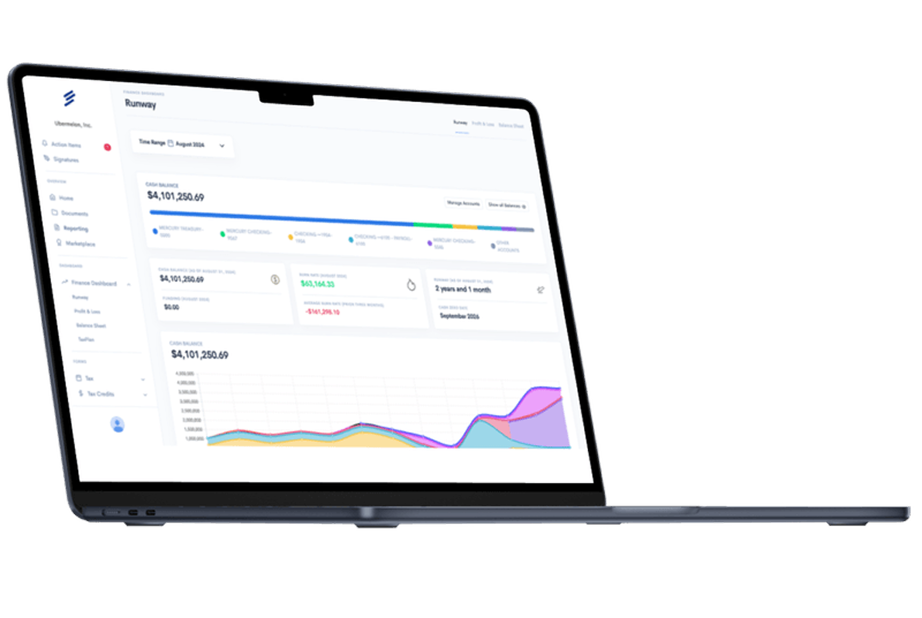Many startup employees and founders struggle with the complexities of equity compensation – a challenge that can profoundly impact both personal wealth and a company’s growth.
Many startup employees and founders struggle with the complexities of equity compensation – a challenge that can profoundly impact both personal wealth and a company's growth. Startup strike price options are often misunderstood, leading to common pitfalls in understanding the agreed-upon price at which company shares can be purchased. This blog post offers a comprehensive solution by breaking down key components such as the strike price (also known as the exercise price or grant price), vesting schedule, tax implications, and different types of employee stock options. Whether you're a prospective employee eyeing a slice of the startup equity or a founder designing compensation packages, read on to gain a solid understanding of these financial instruments and to make informed decisions that can turn paper gains into real money.
Understanding Strike Price Fundamentals
The strike price forms the foundation of any stock option agreement in the startup world. At its essence, the strike price (or exercise price) represents the fixed price at which an employee can purchase company shares once their stock options vest. This price is determined when the options are initially granted, typically through an independent 409A valuation process that establishes the fair market value of the company's common stock.
Early-stage startup employees often receive options with attractively low strike prices, creating a powerful incentive to join growing companies. Imagine joining a seed-stage startup where your options have a $1 strike price, and years later, the company goes public at $50 per share – that $49 difference represents your potential profit per share. This price remains locked in throughout the option's lifetime, regardless of how much the company's value increases.
The timing of when you receive your options matters tremendously. As companies mature and approach funding rounds or exit events, strike prices typically increase to reflect the growing company valuation. This creates a significant advantage for early employees who secured options when prices were lower, potentially setting them up for substantial financial gains if the company succeeds.
Strike prices also play a crucial role in your financial planning strategy. Understanding exactly what your strike price means helps you calculate potential returns, plan for exercise costs, and develop tax strategies that maximize your equity's value. Many employees underestimate the importance of this number until they're facing exercise decisions years later.
The Critical Role of 409A Valuations
A 409A valuation represents an independent assessment of a private company's common stock value, conducted by specialized valuation providers. These valuations aren't arbitrary – they follow specific Internal Revenue Service (IRS) guidelines designed to ensure stock options are priced fairly. Companies typically conduct these valuations annually or after significant business events like funding rounds.
Setting the appropriate strike price through proper 409A valuations protects both the company and its employees from serious tax consequences. When options are priced below fair market value, the IRS may view the difference as taxable compensation, triggering immediate tax liability even before any actual gains are realized. This scenario can create unexpected tax burdens for employees who thought they were receiving a straightforward benefit.
For founders, maintaining current and defensible 409A valuations provides crucial legal protection. The IRS grants "safe harbor" status to companies that follow proper valuation procedures, significantly reducing the risk of audits or penalties related to option pricing. This protection becomes increasingly important as your company grows and attracts more attention from investors and regulators.
Professional valuation firms analyze multiple factors when conducting 409A valuations:
- Company financial performance and projections
- Recent funding rounds and investor valuations
- Comparable public company metrics
- Industry trends and market conditions
- Company stage and growth trajectory
Types of Stock Options Explained
Understanding the different types of stock options available in startup compensation packages helps you make informed decisions about your equity. The two primary types you'll encounter are Incentive Stock Options (ISOs) and Non-Qualified Stock Options (NSOs), each with distinct characteristics and tax implications.
ISOs offer potentially significant tax advantages but come with specific requirements. These options are exclusively available to employees (not contractors or advisors) and must meet several IRS criteria to maintain their favorable tax treatment. When properly structured and held for qualifying periods, ISOs allow you to defer taxation until you sell the shares and potentially qualify for lower long-term capital gains rates rather than higher ordinary income tax rates.
NSOs provide more flexibility in terms of who can receive them but offer fewer tax advantages. Companies can grant NSOs to employees, board members, contractors, and consultants, making them versatile compensation tools. Unlike ISOs, NSOs typically trigger ordinary income tax on the spread between your strike price and the fair market value when exercised, regardless of whether you sell the shares immediately.
The choice between these option types significantly impacts your tax situation and financial outcomes. Many startups offer a mix of both option types, with executives and key employees often receiving ISOs while advisors and contractors receive NSOs. Understanding which type you have helps you develop appropriate exercise and tax strategies that maximize your equity's value.
Essential Components of Option Plans
A comprehensive stock option plan contains several critical elements that define how your equity will work. These components establish the rules for earning, exercising, and potentially profiting from your options throughout your time with the company and beyond.
The number of options and corresponding ownership percentage forms the foundation of your equity grant. While the raw number of options might seem impressive, what truly matters is what percentage of the company those options represent. A grant of 100,000 options means very different things at companies with 1 million versus 100 million outstanding shares. Always clarify what percentage ownership your options represent when evaluating offers.
Vesting schedules determine when you actually earn the right to exercise your options. The standard startup vesting schedule includes:
- A four-year total vesting period that gradually transfers ownership rights to you.
- A one-year "cliff" where no options vest until your first work anniversary.
- Monthly or quarterly vesting after the cliff, where you earn portions of your grant incrementally.
- Potential accelerated vesting provisions that may apply during acquisition scenarios.
Exercise windows define the timeframe during which you can purchase your vested shares. Traditionally, many companies required departing employees to exercise their options within 90 days of leaving or forfeit them entirely. This created pressure to make significant financial decisions quickly, often requiring substantial cash outlays. More employee-friendly companies now offer extended exercise windows of several years or even the full option term, giving former employees more flexibility.
Additional terms may include provisions for early exercise, transfer restrictions, company repurchase rights, and participation in future funding rounds. These details are typically outlined in your option grant documents and the company's equity incentive plan. Reading these documents carefully helps you understand your rights and restrictions regarding your equity.
Strategic Considerations for Employees
Navigating your equity compensation requires thoughtful strategy beyond simply understanding the mechanics. Your personal financial situation, risk tolerance, and career plans all influence how you should approach your stock options. Making informed decisions about when and how to exercise can significantly impact your financial outcomes.
Timing your exercise decisions involves balancing multiple factors. Exercising early, when the spread between your strike price and the current fair market value is small, can minimize tax implications and start the clock on long-term capital gains treatment. However, this approach requires upfront capital and carries the risk that the company might not succeed, potentially resulting in a complete loss of your investment.
Your cash position plays a crucial role in your option strategy. Consider these financial factors when planning your approach:
- The total cost to exercise all your vested options
- Potential tax liabilities triggered by exercise
- Your emergency fund and other financial priorities
- Alternative investment opportunities available to you
- Your timeline for potentially accessing liquidity
Understanding "golden handcuffs" helps you make clearer career decisions. This term refers to the financial incentives that keep employees at companies even when they might otherwise leave. With traditional 90-day exercise windows, leaving before a liquidity event might mean abandoning valuable equity because you can't afford to exercise. Extended exercise windows reduce this pressure, giving you more freedom to make career moves without sacrificing your earned equity.
Tax Implications of Stock Options
The tax consequences of stock options can be complex and significantly impact your financial outcomes. Understanding the basic tax principles helps you develop strategies that maximize your after-tax returns and avoid unexpected tax bills that could derail your financial plans.
Different option types trigger different tax treatments. With ISOs, you generally don't pay taxes when you exercise, though the spread may trigger Alternative Minimum Tax (AMT) in certain situations. If you hold the shares for at least one year after exercise and two years after the grant date, any gains qualify for favorable long-term capital gains rates. NSOs, by contrast, generate ordinary income tax on the spread between your strike price and the fair market value when exercised.
The timing of your exercise decisions significantly impacts your tax situation. Exercising when the spread between your strike price and fair market value is small minimizes immediate tax implications. Some employees exercise options immediately upon vesting or even utilize early exercise provisions to start the holding period for long-term capital gains treatment as soon as possible.
Working with qualified tax professionals becomes increasingly important as your equity position grows. Stock option taxation involves complex interactions between regular income tax, AMT, state taxes, and capital gains considerations. A tax advisor with specific experience in equity compensation can help you develop personalized strategies that account for your complete financial picture and minimize your overall tax burden.
Liquidity Considerations and Exit Planning
Understanding potential paths to liquidity helps you develop realistic expectations about when and how your equity might convert to actual cash. Unlike public company stock options, startup equity typically remains illiquid until a company-wide exit event occurs.
The most common liquidity paths include:
- Initial Public Offering (IPO) where the company lists on a public stock exchange, allowing employees to eventually sell shares on the open market.
- Acquisition by another company, which may result in cash payouts or conversion to the acquiring company's stock.
- Secondary markets where private company shares can sometimes be sold to qualified investors before a public exit.
- Company-sponsored tender offers where the company or its investors purchase shares from employees during funding rounds.
Each liquidity path comes with different timelines, tax implications, and potential values. IPOs typically offer the highest potential upside but may come with post-IPO lockup periods that prevent immediate selling. Acquisitions often provide more immediate liquidity but might value the company differently than you expected. Understanding these dynamics helps you set realistic expectations about your equity's future value.
Planning for potential exits requires balancing optimism with pragmatism. While startup success stories make headlines, the statistical reality is that most startups don't achieve billion-dollar exits. Developing a financial plan that doesn't depend entirely on your equity hitting a home run helps you maintain financial stability while still participating in potential upside.
Negotiating Equity Compensation
Approaching equity negotiations with knowledge and confidence helps you secure packages that fairly reflect your value to the company. Understanding market standards for your role, level, and industry provides crucial context for evaluating offers and requesting adjustments when appropriate.
When evaluating equity offers, focus on percentage ownership rather than the raw number of options. A grant of 10,000 options means very different things at different companies depending on their capitalization structure. Request information about the company's fully-diluted share count to calculate your actual ownership percentage, and consider how future funding rounds might dilute your position over time.
Equity negotiations extend beyond just the number of options. Consider negotiating these additional terms that can significantly impact your equity's value:
- Accelerated vesting provisions that protect your equity in acquisition scenarios
- Extended post-termination exercise windows that give you more flexibility
- Early exercise rights that may offer tax advantages
- Refresher grants after completing significant portions of your initial vesting
Remember that equity represents just one component of your total compensation package. Balancing salary, benefits, equity, and other factors helps you create a compensation structure that meets your current financial needs while participating in potential future upside.
Unlock Your Equity's Full Potential Today
Understanding the intricacies of startup strike price options transforms what might seem like abstract numbers into powerful financial tools. The knowledge you've gained about valuation methods, option types, tax implications, and strategic considerations provides a foundation for making confident decisions about your equity compensation.
Your equity represents more than just potential financial gain – it reflects your contribution to building something meaningful. By approaching your options with informed strategy rather than passive acceptance, you take control of an important aspect of your financial future. Whether you're considering early exercise to optimize tax treatment, planning for a potential exit, or negotiating a new compensation package, your understanding of these concepts gives you agency in the process.
Take proactive steps to maximize your equity's value by consulting with financial and tax professionals who specialize in startup compensation. These experts can help you develop personalized strategies that align with your financial goals, risk tolerance, and timeline. The investment in professional guidance often pays significant dividends by helping you avoid costly mistakes and optimize your approach to this complex asset class.
Remember that equity compensation represents just one component of your broader financial picture. Integrating your option strategy with your overall financial plan ensures that you're making decisions that support your complete financial wellbeing rather than viewing your equity in isolation. By taking this holistic approach, you position yourself to benefit from startup success while maintaining financial stability regardless of outcomes.
Simplify Startup Finances Today
Take the stress out of bookkeeping, taxes, and tax credits with Fondo’s all-in-one accounting platform built for startups. Start saving time and money with our expert-backed solutions.
Get Started









.png)









